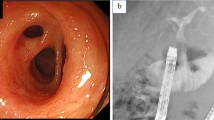Abstract
Twenty-five patients with biliary atresia were treated by a modification of Kasai's hepatic portoenterostomy operation. The midportion of the Roux-en-Y bilioenteric conduit was exteriorized as a Mikulicz anastomosis. This type of biliary reconstruction permitted precise analysis of the biliary drainage, including determinations of the concentrations and types of microorganisms infecting the bilioenteric conduit before, during, and after episodes of cholangitis.
Cholangitis was a universal complication in all patients having sustained bile drainage and, paradoxically, was a hallmark of a successful operation. Attacks of infection were frequent for the first 6 to 9 months. There was no correlation between types and amounts of bacteria in the bile drainage and episodes of cholangitis. Therefore, bile culture data were of no use in selection of specific antibiotic treatment. Nevertheless, antibiotics effective against enteric microorganisms usually cured the infection promptly. Maneuvers that may be helpful in lessening the incidence and severity of cholangitis during this early period consist of exteriorization of the bilioenteric conduit to ensure unimpeded flow of bile, use of choleretic agents, and preventive use of antibiotics.
A second period in which patients were at risk occurred 1–2 years after operation. In this instance, cholangitis was almost invariably a consequence of simple mechanical obstruction of the bilioenteric conduit. Early crushing of the Mikulicz spur and postponement of closure of the bilioenteric conduit were found to be important in prevention of cholangitis during this period.
Résumé
Vingt-cinq malades atteints d'atrésie biliaire ont été opérés selon une variante de l'hépaticoentérostomie de Kasai: la portion médiane de l'anse intestinale montée en Y à la Roux est extériorisée comme dans une anastomose type Mikulicz. Ce type de reconstruction biliaire permet une analyse précise du drainage biliaire, avec détermination et numération des germes infectant le trajet anastomotique avant, pendant et après les épisodes d'angiocholite.
L'angiocholite a été une complication de tous les cas de drainage biliaire. Elle a même été, paradoxalement, un signe de succès de l'opération. Les accès ont été fréquents pendant les 6–9 premiers mois postopératoires. Il n'y a pas de corrélation entre type et nombre de germes et accès d'angiocholite. Les résultats des cultures de bile sont donc inutiles pour la prescription d'antibiotiques spécifiques. L'infection est rapidement contrôlée par des antibiotiques efficaces contre les bactéries du groupe entérique. Certains facteurs peuvent être utiles pour réduire la fréquence et la gravité des épisodes d'angiocholite postopératoire: extériorisation de l'anse montée pour assurer un bon drainage biliaire, agents cholérétiques, antibiothérapie préventive.
Il existe, chez les opérés, une deuximème période de risque d'angiocholite, 1–2 ans après l'opération. Elle résulte alors, presque toujours, d'une obstruction mécanique simple du conduit bilioentérique. Pour la prévenir, deux gestes sont utiles: écraser précocement l'éperon du Mikulicz, retarder la fermeture de la fistule entérique.
Similar content being viewed by others
References
Carcassonne, M., Bensoussan, A.: Long-term results in treatment of biliary atresia. In Progress in Pediatric Surgery, Vol. 10, P.P. Rickham, W.C. Hecker, and J. Prevot, editors. Baltimore-Munich, Urban and Schwarzenberg, 1977, p. 151
Lilly, J.R., Altman, R.P.: Hepatic portoenterostomy (the Kasai operation) for biliary atresia. Surgery78:76, 1975
Lilly, J.R., Javitt, N.B.: Biliary lipid excretion after hepatic portoenterostomy. Ann. Surg.184:369, 1976
Kasai, M.: Treatment of biliary atresia with special reference to hepatic porto-enterostomy and its modifications. In Progress in Pediatric Surgery, Vol. 10, A.H. Bill and M. Kasai, editors. Baltimore-London-Tokyo, University Park Press, 1974, p. 5
Hirsig, J., Kara, O., Rickham, P.P.: Experimental investigations into the etiology of cholangitis following operation for biliary atresia. J. Pediatr. Surg.13:55, 1978
Danks, D.M., Campbell, P.E., Clarke, A.M., Jones, P.G., Solomon, J.R.: Extrahepatic biliary atresia. The frequency of potentially operable cases. Am. J. Dis. Child.128:684, 1974
Kasai, M., Kimura, S. Asakura, Y., Suzuki, H., Taira, Y., Ohashi, E.: Surgical treatment of biliary atresia. J. Pediatr. Surg.3:665, 1968
Author information
Authors and Affiliations
Additional information
This work was supported in part by a grant (RR-69) from the General Clinical Research Centers Program of the Division of Research Resources, National Institutes of Health.
Rights and permissions
About this article
Cite this article
Lilly, J.R., Hitch, D.C. Postoperative ascending cholangitis following portoenterostomy for biliary atresia: Measures for control. World J. Surg. 2, 581–585 (1978). https://doi.org/10.1007/BF01556050
Issue Date:
DOI: https://doi.org/10.1007/BF01556050




